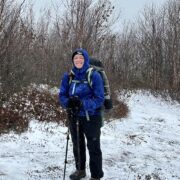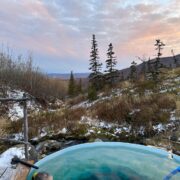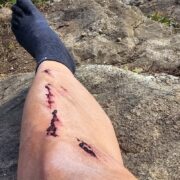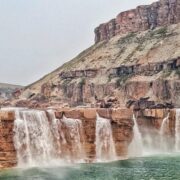I recently returned from a wilderness hot springs backpacking trip with 5 women friends. The trailhead is remote, and the trail itself is only 10 miles, but with some significant elevation gain and loss, starting with an 1100 foot drop, then a 1200 foot gain, and another 1100 foot drop into the springs area. Returning you reverse all of those gains and losses. No switchbacks. There’s also 1-2 miles of bog at the bottom of the first descent, which can be knee to thigh deep mud in summer. We didn’t know if it would be frozen yet or not. The location is always windy, sometimes insanely so with 40mph gusts on the dome, and weather is somewhat unpredictable despite forecasts. And you’re on your own; there are no services nearby, and while there are rental cabins with woodstoves, there’s no one there to light the fire for you. You really need to be self-sufficient and strong. There is no cell service at the springs, on the trail, or on the road to the trailhead. Oh, and there are plenty of wolves and grizzlies (although tbh, I have never seen any out there, only tracks). Our trail intel pre-trip said that the bears were still out, because the blueberries were still plentiful (they were, yum!).
So all of that trail info informs the gear list. The unknowns mean packing more and packing smarter. I don’t have a full list to share (because I’m too lazy to put it in a shareable format), but I’ll highlight some of the less common items that were essential or at least very useful for these conditions. I recently listened to the BPL podcast Ryan did on layering for fall conditions, and it somewhat reflects what I do, but I always, always end up wet. I have never found a way around that and plan/pack accordingly. If I don’t wear enough clothing, I shiver. If I wear enough to be warm, I sweat and am wet, especially in high winds.
We started out with a forecast of light snow all weekend, and wind of 10-20mph gusts. Temperatures were in the 25-35F range, which means snow can also be rain, which means getting very wet outside and inside. Although the total accumulation expected was only a few inches, in that area it can be much heavier than predicted. We could go out in 2 inches and come back with 2 feet of snow. It does happen.
I started out in a lightweight Patagonia capilene baselayer top and bottom, with ski pants and a midweight fleece sweater. I added a PG Houdini, an Enlightened Equipment puffy and down mittens at the trailhead parking lot, because it is super crazy windy and cold there, always. Biting cold. As soon as we were in the trees, I removed the puffy and mittens. I wore Sealskinz socks and Keen Targhee mid boots, with OR knee high waterproof gaiters, since we weren’t sure of the bog conditions. I should have had my Nanospikes, but at the last minute, set them aside in favor of snowshoes, which I ended up leaving in the car at the TH because there wasn’t much snow. Why do I do that?! I had packed correctly the first time! Fortunately a friend had some grippers I borrowed which were essential for the icy conditions. The bog was mostly frozen, with some soft overflow ice. Hard to get solid footing.
Beautiful day and we took our time heading out. Two of our party had injuries to contend with, so our progress was not fast. Once we summited the dome, we had gorgeous views of the flats and many lakes and streams below and a lovely sunset. I added the puffy again along with waterproof overmitts when we hit the top of the mountain and the wind, and then started our final descent. I keep those things in a plastic bag inside the outer mesh pocket, for easy on/off throughout a hike. The good thing traveling in is that you know there are cabins with woodstoves, and tubs full of steaming hot water awaiting you!
The return journey two days later was easier starting out, since our packs were lightened, but the snow started midway through and got heavier and heavier throughout the day. By the last climb we were trudging in 3-5 inches of fresh wet snow, straight uphill, slipping and sliding the whole way. When we arrived at the parking lot, we climbed into the cars and took off. I should have changed immediately into my dry clothes; I didn’t change because we had a car heater. The vehicle I was in ended up in an accident, and being in wet clothes was not a good thing. Lesson learned. Always change immediately when you stop hiking. Just do it.
My pack was 24 pounds starting with 1 liter water, quite a bit of heavy shared meal food like bricks of cheese, plus I added another 2 pounds for wine (given to me at trailhead!). I used almost every thing in my pack, except an extra pair of dry socks, an extra balaclava, and an extra warm cap; all of these are things I would pack again, for ensuring having dry gear if needed. It’s lifesaving, literally. You skimp at your peril in these conditions. I also had some chemical handwarmers, not used, which I would also pack again. I had quite a bit of redundancy – extra socks (so 2 pair packed), extra gloves, extra puffy – I used all of these. Overall I was happy with my packing, the only exception being I would bring the Nanospikes next time.
Some of the essential gear for this trip:
- Gripper devices for boots
- Warm footwear system
- Balaclava
- Ski goggles for walking into the wind
- Waterproof overmitts
- Puffy pants and jacket for camp
- Extra baselayer for camp or for emergency
- Lightweight towel for the hot spring tubs
- Foam mat to stand on getting in and out of tubs on snow/ice
Overall a really wonderful trip with good friends. Lots of laughs, crazy conversations, too much food, and deep sleep in cozy cabins listening to the howling wind. Here are a few photos.













Home › Forums › Remote hot springs fall trip